We entered the long bay leading to the city of Santiago de Cuba around 10.00pm on March 31st. While sailing the buoyed channel signaling the path to the marina, we were cheerfully greeted by the several fishermen going the opposite way for a night of work. After several attempts, we were able to get the anchor to hold in the muddy bottom close to the marina. The following morning we were waken up by somebody knocking the hull – it was the medical officer coming to inspect our provisions and investigating issues related to our health state. She also gave us some advise on how to treat water, protect against mosquitoes, etc.
This was only the first of several authorities that came on board. After moving to the dock, officers from customs, port authority, immigration and drug prevention thoroughly inspected every corner of the boat , finally giving us the “despacho” to cruise the Cuban waters.
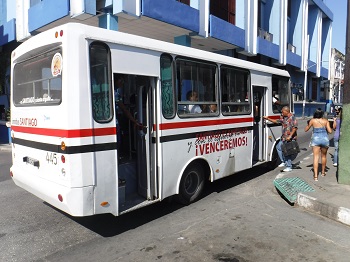
Bus from the marina to the city center
After complying with the bureaucratic procedures, we took a public bus to the city center. This was our first colorful encounter with the Cuban atmosphere: the bus driver welcomed us with a large smile, moving at the rhythm of the salsa music that was playing in the background.
When we got to downtown we had the fortune to meet a university professor working at the Study Center of Antonio Macheo , a hero of the Independence War against Spain in the late 1800.
He invited us to his house and gave us as a present copies of magazines where he published articles on Cuban history. We spent the evening together ending at the Casa della Trova, a place where they play traditional Cuban music.
It was a great introduction to Santiago, which we explored in more depth in the following days, refilling our food reserve with local vegetables and fruit that we could finally find locally produced and at a very cheap price.
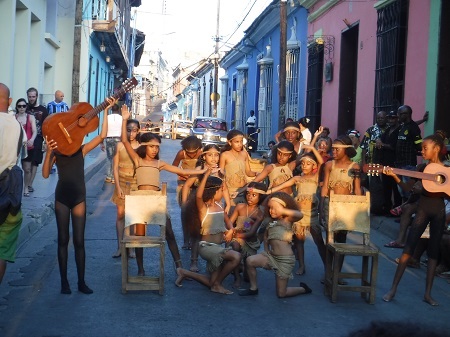
Music and ballet in the street
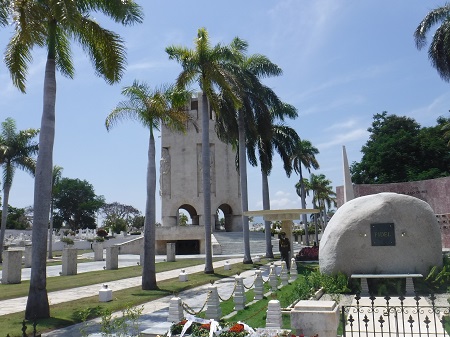
Cemetery of Santa Ipifenia
We were impressed by the lively atmosphere of the city that is the most Caribbean-like province of Cuba. Music was everywhere at any time of the day, with people of every age and status dancing in the streets. On the other hand, the high level of poverty became quite obvious walking in the streets.
Santiago has noticeable buildings from the colonial age, several museums and historical sites that testify the revolution period. We had the chance to visit the cemetery of “Santa Ifigenia”, where important figures of the Cuban history are buried, including Fidel Castro.
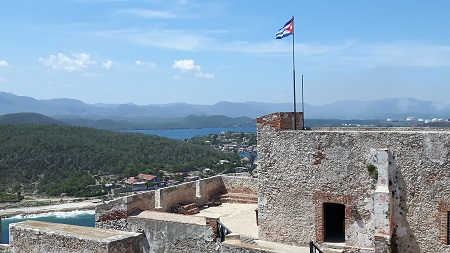
Castillo el Morro
Taking a brief ferry ride from the marina, we visited the islet of Granma as well as the Castillo El Morro, that was built by the Spaniards in the 17th century to protect Santiago from the attack of the pirates financed by France and England.
On April 5th we met Clara, a friend of us arriving from Italy, at the Parque De Cespedes.
The following morning we left the marina heading towards Chivirico, a small village south west of Santiago. We dropped anchor in a very protected lagoon – with a heart beating access – we almost touched the sand bottom at the very entrance!
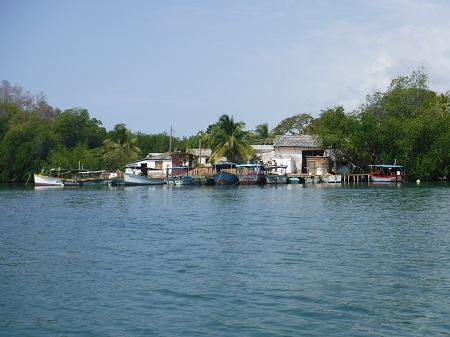
Civirico – The fishermen’s dock
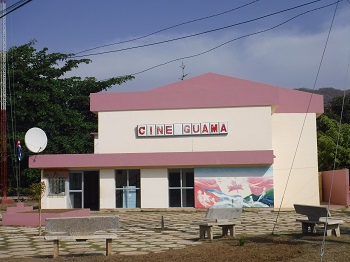
Chivirico – Cine Guama
The following day we left our dinghy at the fishermen’s dock to do some provisioning at the local vegetable and fruit market. We could fill our empty fridge of eggplants, peppers, onions, cucumbers, bananas and tomatoes for a total of 4 CUC (1 CUC = 1 euro).
When we got back to the dock we had a heart attack not seeing our dinghy were we left it! Some fisherman urged to reassure us that the “guardafronteras” (coast guard) borrowed it to reach another sailboat anchored close to Zoe. We patiently waited their return expecting some check on us, especially because we were told we could not land in Chivirico. Unexpectedly they were kind of ashamed – they thanked us for the use of the dinghy and helped us load our goods wishing us a safe journey.
We left anyhow heading to Marea del Portillo that was described as a lively touristic place. For us it was a convenient stop on our way west. We explored the tiny village consisting of very poor houses; we were really touched by a man who invited us to his house offering as a gift a small pack of coffee and lots of onions, refusing any money but asking for any used clothes that we could leave. We were also impressed by seeing a shop reserved to people exhibiting the “libreta” – an allowance for basic alimentary needs, such as bread, milk, etc. We left the village with a feeling of sorrow and helplessness.
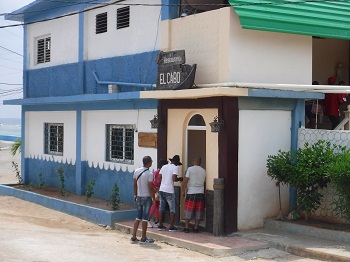
Cabo Cruz – Restaurant
We continued towards Cabo Cruz, the west end tip of the coast we were navigating. We anchored at night in the very sheltered bay in front of the lighthouse – built in the 1871. In the morning we were waken up by the knocking of the “guardafronteras” who wanted to check our “despacho” – the authorization to sail the Cuban waters. With a very friendly attitude, they recommended to visit the small village and to have lunch at the only restaurant of the village. We had a good meal for less than 5 euros for the 3 of us – including beers which we paid twice as much the food itself. On our way back to the dinghy we were offered at a real bargain price a few lobsters – we walked back to the boat with our dinner! In the afternoon we did some good snorkeling in the nearby reef, where we could admire a great variety of coral.
Cuba – from Santiago to Cabo Cruz
We entered the long bay leading to the city of Santiago de Cuba around 10.00pm on March 31st. While sailing the buoyed channel signaling the path to the marina, we were cheerfully greeted by the several fishermen going the opposite way for a night of work. After several attempts, we were able to get the anchor to hold in the muddy bottom close to the marina. The following morning we were waken up by somebody knocking the hull – it was the medical officer coming to inspect our provisions and investigating issues related to our health state. She also gave us some advise on how to treat water, protect against mosquitoes, etc.
This was only the first of several authorities that came on board. After moving to the dock, officers from customs, port authority, immigration and drug prevention thoroughly inspected every corner of the boat , finally giving us the “despacho” to cruise the Cuban waters.
Bus from the marina to the city center
After complying with the bureaucratic procedures, we took a public bus to the city center. This was our first colorful encounter with the Cuban atmosphere: the bus driver welcomed us with a large smile, moving at the rhythm of the salsa music that was playing in the background.
When we got to downtown we had the fortune to meet a university professor working at the Study Center of Antonio Macheo , a hero of the Independence War against Spain in the late 1800.
He invited us to his house and gave us as a present copies of magazines where he published articles on Cuban history. We spent the evening together ending at the Casa della Trova, a place where they play traditional Cuban music.
It was a great introduction to Santiago, which we explored in more depth in the following days, refilling our food reserve with local vegetables and fruit that we could finally find locally produced and at a very cheap price.
Music and ballet in the street
Cemetery of Santa Ipifenia
We were impressed by the lively atmosphere of the city that is the most Caribbean-like province of Cuba. Music was everywhere at any time of the day, with people of every age and status dancing in the streets. On the other hand, the high level of poverty became quite obvious walking in the streets.
Santiago has noticeable buildings from the colonial age, several museums and historical sites that testify the revolution period. We had the chance to visit the cemetery of “Santa Ifigenia”, where important figures of the Cuban history are buried, including Fidel Castro.
Castillo el Morro
Taking a brief ferry ride from the marina, we visited the islet of Granma as well as the Castillo El Morro, that was built by the Spaniards in the 17th century to protect Santiago from the attack of the pirates financed by France and England.
On April 5th we met Clara, a friend of us arriving from Italy, at the Parque De Cespedes.
The following morning we left the marina heading towards Chivirico, a small village south west of Santiago. We dropped anchor in a very protected lagoon – with a heart beating access – we almost touched the sand bottom at the very entrance!
Civirico – The fishermen’s dock
Chivirico – Cine Guama
The following day we left our dinghy at the fishermen’s dock to do some provisioning at the local vegetable and fruit market. We could fill our empty fridge of eggplants, peppers, onions, cucumbers, bananas and tomatoes for a total of 4 CUC (1 CUC = 1 euro).
When we got back to the dock we had a heart attack not seeing our dinghy were we left it! Some fisherman urged to reassure us that the “guardafronteras” (coast guard) borrowed it to reach another sailboat anchored close to Zoe. We patiently waited their return expecting some check on us, especially because we were told we could not land in Chivirico. Unexpectedly they were kind of ashamed – they thanked us for the use of the dinghy and helped us load our goods wishing us a safe journey.
We left anyhow heading to Marea del Portillo that was described as a lively touristic place. For us it was a convenient stop on our way west. We explored the tiny village consisting of very poor houses; we were really touched by a man who invited us to his house offering as a gift a small pack of coffee and lots of onions, refusing any money but asking for any used clothes that we could leave. We were also impressed by seeing a shop reserved to people exhibiting the “libreta” – an allowance for basic alimentary needs, such as bread, milk, etc. We left the village with a feeling of sorrow and helplessness.
Cabo Cruz – Restaurant
We continued towards Cabo Cruz, the west end tip of the coast we were navigating. We anchored at night in the very sheltered bay in front of the lighthouse – built in the 1871. In the morning we were waken up by the knocking of the “guardafronteras” who wanted to check our “despacho” – the authorization to sail the Cuban waters. With a very friendly attitude, they recommended to visit the small village and to have lunch at the only restaurant of the village. We had a good meal for less than 5 euros for the 3 of us – including beers which we paid twice as much the food itself. On our way back to the dinghy we were offered at a real bargain price a few lobsters – we walked back to the boat with our dinner! In the afternoon we did some good snorkeling in the nearby reef, where we could admire a great variety of coral.